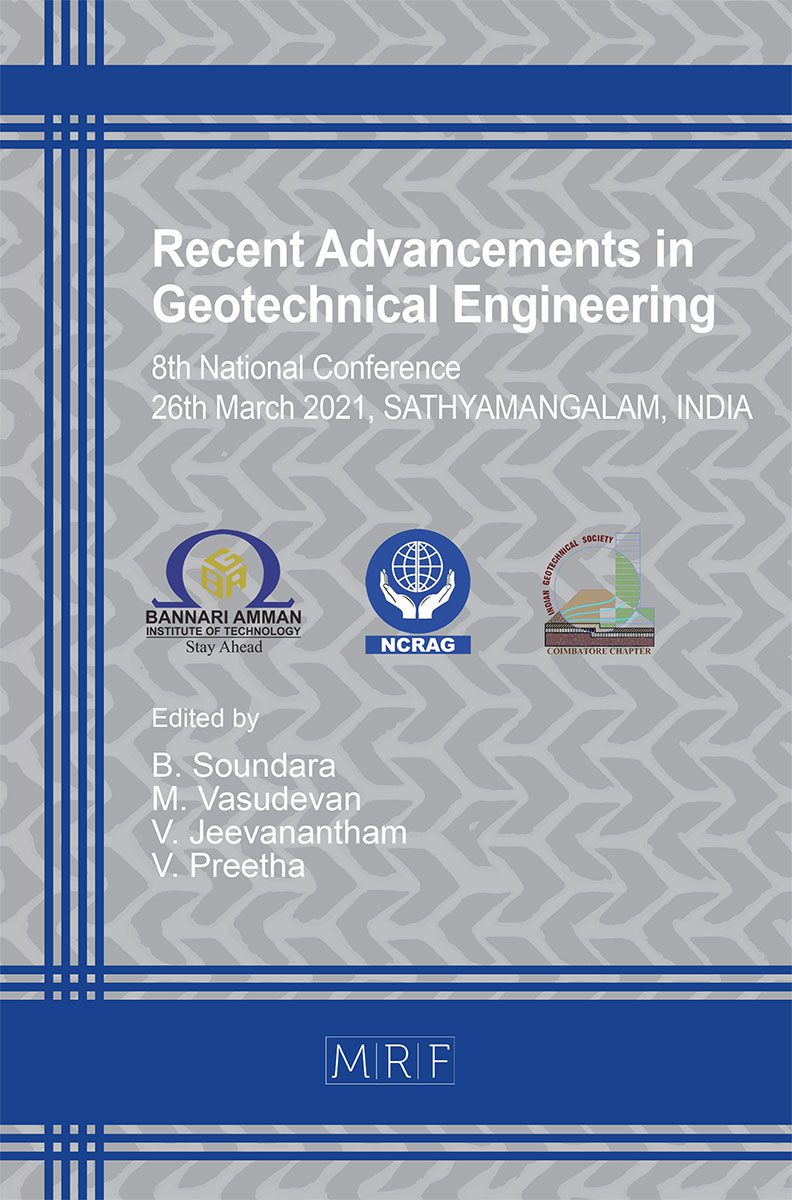Effect of Sulfonated-Melamine Formaldehyde as Superplasticizer in Cementitious Systems
SKM. Pothinathan, J. Millar, S. Christopher Gnanaraj
download PDFAbstract. This paper studied the effect of Sulfonated-Melamine Formaldehyde (SMF) on the water cement ratio, setting time, compressive strength at various ages and an acid resistance test was conducted using sulfuric acid. Sulfonated-Melamine Formaldehyde is classified as superplasticizer. SMF was mixed with concrete at 1%-5% in volume fraction. But not much investigation was made. In this study it was found that the Sulfonated-Melamine Formaldehyde incorporated concrete mixture performing well in strength property and have more resistance to aggressive environment when compared to conventional concrete.
Keywords
Sulfonated-Melamine Formaldehyde, Concrete, Super Plasticizer, Fresh Concrete Properties, Mechanical Strength
Published online 8/15/2021, 9 pages
Copyright © 2021 by the author(s)
Published under license by Materials Research Forum LLC., Millersville PA, USA
Citation: SKM. Pothinathan, J. Millar, S. Christopher Gnanaraj, Effect of Sulfonated-Melamine Formaldehyde as Superplasticizer in Cementitious Systems, Materials Research Proceedings, Vol. 19, pp 51-59, 2021
DOI: https://doi.org/10.21741/9781644901618-7
The article was published as article 7 of the book Recent Advancements in Geotechnical Engineering
![]() Content from this work may be used under the terms of the Creative Commons Attribution 3.0 licence. Any further distribution of this work must maintain attribution to the author(s) and the title of the work, journal citation and DOI.
Content from this work may be used under the terms of the Creative Commons Attribution 3.0 licence. Any further distribution of this work must maintain attribution to the author(s) and the title of the work, journal citation and DOI.
References
[1] MouhcineBen Aicha. (2020). The superplasticizer effect on the rheological and mechanical properties of self-compacting concrete. New Materials in Civil Engineering, Pages 315-331. https://doi.org/10.1016/B978-0-12-818961-0.00008-9
[2] Dhanya Sathyan, , Kalpathy Balakrishnan Anand. (2019). Influence of superplasticizer family on the durability characteristics of fly ash incorporated cement concrete. Construction and Building Materials, 204, 864-874. https://doi.org/10.1016/j.conbuildmat.2019.01.171
[3] Ibragimov, R., & Fediuk, R. (2019). Improving the early strength of concrete: Effect of mechanochemical activation of the cementitious suspension and using of various superplasticizers. Construction and Building Materials, 226, 839–848. https://doi.org/10.1016/j.conbuildmat.2019.07.313
[4] Chee Ban Cheah, Wee Kang Chow, Chuan Wei Oo, Khang Heng Leow (2020). The influence of type and combination of polycarboxylate ether superplasticizer on the mechanical properties and microstructure of slag-silica fume ternary blended self-consolidating concrete, Journal of Building Engineering 31, 101412. https://doi.org/10.1016/j.jobe.2020.101412
[5] Nowak-Michta, A. (2019). Impact analysis of air-entraining and superplasticizing admixtures on concrete compressive strength. Procedia Structural Integrity, 23, 77–82. https://doi.org/10.1016/j.prostr.2020.01.066
[6] Gupta, N., Gupta, A., Saxena, K. K., Shukla, A., & Goyal, S. K. (2020). Mechanical and durability properties of geopolymer concrete composite at varying superplasticizer dosage. Materials Today: Proceedings. https://doi.org/10.1016/j.matpr.2020.05.646
[7] Matsuzawa, K., Atarashi, D., Miyauchi, M., & Sakai, E. (2017). Interactions between fluoride ions and cement paste containing superplasticizer. Cement and Concrete Research, 91, 33–38. https://doi.org/10.1016/j.cemconres.2016.10.006
[8] Nakajima, Y., & Yamada, K. (2004). The effect of the kind of calcium sulfate in cements on the dispersing ability of poly β-naphthalene sulfonate condensate superplasticizer. Cement and Concrete Research, 34(5), 839–844. https://doi.org/10.1016/j.cemconres.2003.09.022
[9] Shawqul M.Lahallh, M.Absl-Halabi, Ali M.Ali. (1988) Effect of polymerization conditions of sulfonated-melamine formaldehyde superplasticizers on concrete. Cement and Concrete Research Volume 18, Issue 4, Pages 513-531. https://doi.org/10.1016/0008-8846(88)90044-0
[10] Arosio, F., Castoldi, L., Ferlazzo, N., & Forzatti, P. (2007). Influence of solfonated melamine formaldehyde condensate on the quality of building blocks production by extrusion of cement–clay pastes. Applied Clay Science, 35(1-2), 85–93. https://doi.org/10.1016/j.clay.2006.06.004
[11] Ruslan Ibragimov, Roman Fediuk.(2019). Improving the early strength of concrete: Effect of mechanochemical activation of the cementitious suspension and using of various superplasticizers. Construction and Building Materials, 22 839-848. https://doi.org/10.1016/j.conbuildmat.2019.07.313
[12] Abdullah M.Zeyad, AliAlmalki. (2020). Influence of mixing time and superplasticizer dosage on self-consolidating concrete properties. Journal of Materials Research and Technology, V9, 6101-6115. https://doi.org/10.1016/j.jmrt.2020.04.013
[13] Meishan Pei, Zhenfei Wang, Wenwei Li, Jin Zhang, Qiwei Pan, Xiaojuan Qin (2008). The properties of cementitious materials superplasticized with two superplasticizers based on aminosulfonate–phenol–formaldehyde. Construction and Building Materials 22 2382–2385. https://doi.org/10.1016/j.conbuildmat.2007.09.003
[14] Meishan Pei, Dujin Wang, Xianbo Hu, Duanfu Xu. (2000). Synthesis of sodium sulfanilate-phenol-formaldehyde condensate and its application as a superplasticizer in concrete. Cement and Concrete Research 30 1841 – 1845. https://doi.org/10.1016/S0008-8846(00)00389-6
[15] Alexander N. Chernysheva, Mats Jonssonb, Kerstin Forsberg (2018). Characterization and degradation of a polyaryl ether based superplasticizer for use in concrete barriers in deep geological repositories. Applied Geochemistry95 172-181. https://doi.org/10.1016/j.apgeochem.2018.05.014
[16] A.A.M. Mahmoud, , M.S.H. Shehab, , A.S. El-Dieb. (2010). Concrete mixtures incorporating synthesized sulfonated acetophenone–formaldehyde resin as superplasticizer. Cement & Concrete Composites 32 392–397. https://doi.org/10.1016/j.cemconcomp.2010.02.005
[17] C Rogin Roberta, Dhanya Sathyana, K B Anand. (2018). Effect of superplasticizers on the rheological properties of fly ash incorporated cement paste. Materials Today: Proceedings 5 23955–23963. https://doi.org/10.1016/j.matpr.2018.10.188
[18] Rixom R, Mailvaganam N. (1999) Chemical admixtures for concrete. 3rd ed. London: E & FN Spon. https://doi.org/10.4324/9780203017241
[19] Chen SD, Hwang CH, Hsu KC. (1999) The effects of sulphonated phenolic resins on the properties of concrete. Cement Concrete Research 29(2) 255–259. https://doi.org/10.1016/S0008-8846(98)00098-2
[20] Pei M, Yang Y, Zhang X, Zhang J, Dong J. (2004) Synthesis and the effects of water-soluble acetone–formaldehyde resin on the properties of concrete. Cement Concrete Research ;34(8):1417–1420. https://doi.org/10.1016/j.cemconres.2004.01.012
[21] Pei M, Wang D, Hu X, Xu D. (2000). Synthesis of sodium sulfanilate–phenol– formaldehyde condensate and its application as a superplasticizer in concrete. Cement Concrete Research 30(11) 1841–1845. https://doi.org/10.1016/S0008-8846(00)00389-6
[22] IS383 – Indian Standard Specification for Coarse and Fine Aggregates from Natural Sources for Concrete
[23] IS 10262 – Indian Standard Concrete Mix Proportioning – Guidelines
[24] IS 516 – Indian Standard Methods of ‘Tests for Strength of Concrete
[25] IS 5816 – Indian Standard Splitting tensile strength of concrete












